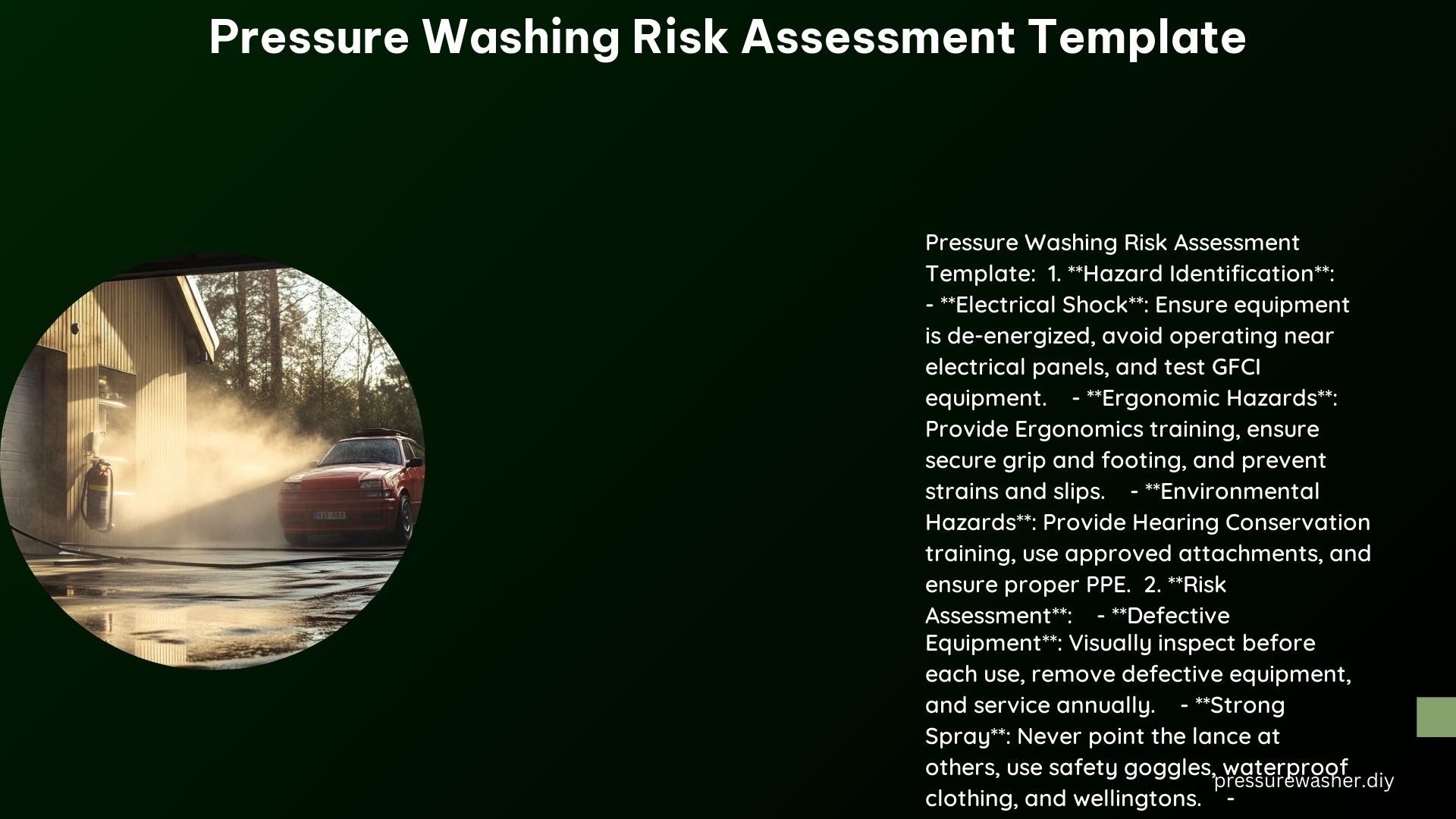Pressure washing is a powerful cleaning technique that can effectively remove dirt, grime, and other contaminants from various surfaces. However, this process also involves several hazards that can lead to injuries and property damage if not properly managed. To mitigate these risks, a comprehensive risk assessment template is essential. This article will provide a detailed guide on the key elements and considerations for a pressure washing risk assessment template.
Key Hazards to Consider
1. Defective Equipment
- Ensure regular maintenance and inspections of pressure washers, hoses, and accessories. This includes checking for worn or damaged components, proper functioning of safety features, and ensuring the equipment is suitable for the intended use.
- Remove any defective equipment from use and repair or replace it promptly. Continuing to use faulty equipment can increase the risk of equipment failure, leading to potential injuries or property damage.
2. Electrical Hazards
- Ensure all equipment is de-energized before washing to prevent the risk of electric shock. This includes unplugging the pressure washer from the power source and verifying that the circuit is isolated.
- Use Residual Circuit Devices (RCDs) on power supplies to provide additional protection against electric shock. RCDs can quickly detect and interrupt the flow of electricity in the event of a fault, reducing the risk of electrocution.
- Carefully inspect electric cables for defects, such as fraying, cracks, or damage to the insulation. Ensure that the cables are suitable for outdoor use and can withstand the environmental conditions during pressure washing.
3. Slips, Trips, and Falls
- Coil hoses neatly during use and storage to prevent tripping hazards. Ensure that hoses are not left in walkways or areas where people may be working.
- Maintain good traction on walking surfaces by using non-slip mats or grating in areas where water may accumulate. This can help prevent slips and falls, which can lead to serious injuries.
4. Hand-Arm Vibration
- Limit exposure to vibration by dividing the work into shorter intervals and providing regular breaks. Prolonged exposure to vibration can lead to hand-arm vibration syndrome, a condition that can cause permanent damage to the nerves, blood vessels, and muscles in the hands and arms.
- Provide hand-arm vibration training to operators and ensure the use of appropriate personal protective equipment (PPE), such as anti-vibration gloves, to minimize the impact of vibration.
5. Chemical Exposure
- Use appropriate PPE, such as chemical-resistant gloves and goggles, when handling cleaning agents or other chemicals used in the pressure washing process.
- Follow the safety guidelines and instructions provided by the chemical manufacturer to ensure safe handling and use.
6. Ergonomic Hazards
- Provide ergonomic training to operators on proper lifting techniques and body positioning to minimize the risk of musculoskeletal disorders.
- Ensure that operators maintain a secure grip and stable footing when operating the pressure washer to prevent strain or overexertion.
7. Environmental Hazards
- Implement proper disposal methods for waste and cleaning agents used during the pressure washing process to minimize environmental impact.
- Minimize noise exposure by using quieter equipment or providing hearing protection, such as earplugs or earmuffs, to operators.
Technical Specification of Pressure Washing Risk Assessment Template

1. Risk Assessment Template
- Use a template that includes columns for hazards, risks, risk ratings, control measures, and implementation details. This will help you systematically identify, assess, and manage the various risks associated with pressure washing.
2. Risk Rating
- Utilize a risk rating system, such as High, Medium, and Low, to prioritize the control measures and ensure that the most significant risks are addressed first.
- For example, a “High” risk rating may indicate a hazard that is likely to cause severe injury or significant property damage, while a “Low” risk rating may represent a hazard with a low probability of occurrence and minimal consequences.
3. Control Measures
- Implement appropriate control measures to mitigate the identified risks. These may include regular maintenance, the use of personal protective equipment (PPE), and the implementation of safe operating procedures.
- Assign responsibilities for the implementation of control measures and track the completion dates to ensure that the necessary actions are taken.
4. Training and PPE
- Provide comprehensive training to operators on the various hazards associated with pressure washing, including hand-arm vibration, ergonomics, and the proper use of PPE.
- Ensure that operators are equipped with the necessary PPE, such as safety goggles, waterproof clothing, and hearing protection, to protect themselves during the pressure washing process.
Ensuring Safe Operation of a Hot Water Pressure Washer
1. Regular Maintenance
- Service the pressure washer annually and keep detailed records of the maintenance activities. This includes inspecting and replacing worn or damaged components, as well as ensuring the proper functioning of safety features.
- Conduct a thorough inspection of the pressure washer before each use, checking for any defects or issues that may compromise the safety of the equipment.
2. Proper Use
- Ensure that operators are trained on the safe operating procedures for the pressure washer, including the proper techniques for handling the equipment and adjusting the pressure settings.
- Use the lowest pressure setting suitable for the job to minimize the risk of aerosol production, which can increase the potential for exposure to contaminants or chemicals.
3. Safety Precautions
- Cordon off the work area during pressure washing to prevent unauthorized access and reduce the risk of injury to bystanders.
- Never point the pressure washer lance at others or direct the high-pressure jet at fragile surfaces, as this can cause serious injury or damage.
References
- Health and Safety Authority (HSA). (n.d.). No. 49 Pressure Washer. Retrieved from https://www.hsa.ie/eng/Education/Managing_Safety_and_Health_in_Schools/Interactive_Risk_Assessments_%E2%80%93_Primary/No-49-Pressure-Washer.pdf
- HSEDocs. (n.d.). Risk Assessment for Pressure Washer. Retrieved from https://www.hsedocs.com/all-documents/pressure-washer-risk-assessment/
- South Central College. (2017). Pressure Washer.pdf – Job Hazard Analysis. Retrieved from https://southcentral.edu/webdocs/safety_committee/Job_Hazard_Analysis/Pressure%20Washer.pdf
- Health and Safety Authority (HSA). (n.d.). Maintenance (Pressure Washers) – Risk Assessment Template No. 42. Retrieved from https://www.hsa.ie/eng/education/managing_safety_and_health_in_schools/new_guidelines_files/maintenance-_pressure-washers_%E2%80%93no-42.pdf
- CleanItUp. (2010). Pressure Washing Risk Assessments Template and Health and Safety. Retrieved from http://www.cleanitup.co.uk/smf/index.php?topic=91895.0
